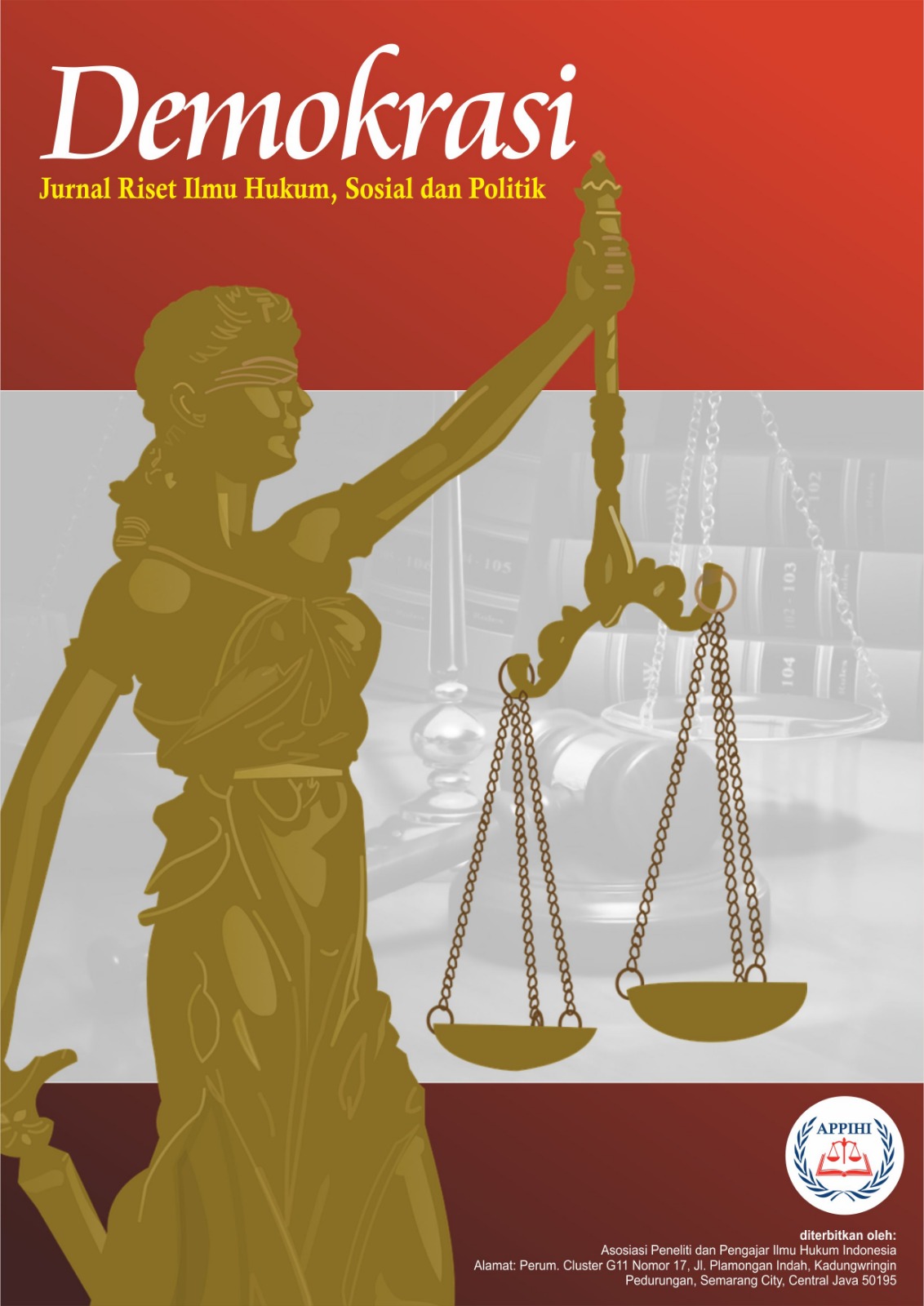Partisipasi Masyarakat Dalam Pembangunan Desa di Desa T’eba dan Desa T’eba Timur Kecamatan Biboki Tanpah, Kabupaten Timor Tengah Utara
DOI:
https://doi.org/10.62383/demokrasi.v2i1.697Keywords:
Community Participation, Village Development, Inhibiting Factors, T’eba Village, T’eba Timur VillageAbstract
This study aims to analyze community participation in village development in T’eba Village and T’eba Timur Village, Biboki Tanpah Subdistrict, Timor Tengah Utara Regency, and to identify the factors that hinder it. Village development is one of the key elements in improving community welfare. However, low community participation poses a challenge that hampers the achievement of inclusive and sustainable development goals. T’eba Village exhibits a higher level of community participation compared to T’eba Timur Village, yet both face challenges that affect the success of their development. The research methodology employed is empirical juridical with socio-legal and conceptual approaches. Primary data were obtained through interviews, observations, and questionnaires, while secondary data were sourced from official documents and related literature. Data analysis was conducted using qualitative descriptive techniques to interpret the research findings. The results show that community participation in T’eba Village reached 82.61%, whereas in T’eba Timur Village, it was only 30.44%. This disparity is attributed to higher community awareness in T’eba Village and better support from the village government in engaging the community. Factors hindering community participation include educational disparities, a lack of awareness about the importance of village development, economic conditions prioritizing subsistence needs, and community perceptions of the effectiveness of the village government. For example, residents of T’eba Timur Village are less involved because they feel that development programs do not directly benefit their livelihoods, particularly in agriculture, which is their primary occupation. This study recommends enhancing community involvement through education, economic empowerment, and strengthening the capacity of village governments to create inclusive and transparent participatory mechanisms. Moreover, it emphasizes the need for coordination between the community and village governments to formulate development policies that are more responsive to local needs. With this approach, village development can become more relevant, sustainable, and impactful for the community.
Downloads
References
Abidin, D. (2023). Perencanaan pembangunan partisipasi desa. Eureka Media Aksara.
Bihamding, H. H. (2019). Perencanaan pembangunan partisipasi desa. Yogyakarta.
Bintarto, R. (1986). Desa-Kota. Alumni.
Daldjoeni, N. (1987). Interaksi desa-kota. Rineka Cipta.
Ernawati, & Purwaningsih. (2008). Partisipasi masyarakat dalam pembangunan desa. Jurnal Jantra, 3(6), 1–14.
Evrati, D., & Putra, S. (2021). Kebijakan dana desa: Pemberdayaan masyarakat dan pembangunan desa. Dewi.
Gwinjangge, P., Darman, D., & Rijal, R. (2022). Partisipasi masyarakat desa dalam pembangunan infrastruktur. CV. Cahaya Arrsh Publisher dan Printing.
Hadawiya, R., Muda, I., & Batubara, B. M. (2021). Partisipasi masyarakat dalam musyawarah perencanaan pembangunan desa. Strukturasi: Jurnal Ilmiah Magister Administrasi Publik, 3(2), 192–200.
Hakim, L. (2017). Partisipasi masyarakat dalam pembangunan desa Sukamerta Kecamatan Rawamerta Kabupaten Karawang. Jurnal Politikom Indonesiana, 2(2), 45–49.
Harfis, H., Sopyan, S., & Afrizal, D. (2019). Faktor penghambat partisipasi masyarakat dalam pembangunan desa. Jurnal Administrasi Publik dan Bisnis, 1(2), 30–37.
Ibran, S. (2018). Partisipasi masyarakat dalam pembangunan desa (studi di Desa Lerepako Kecamatan Laeya Kabupaten Konawe Selatan). Jurnal Penelitian Pendidikan Geografi, 3, 1–10.
Karianga, H. (2011). Partisipasi masyarakat dalam pengelolaan keuangan daerah. PT Alumni.
KKN Kelompok 50 UIN SU Medan. (2022). Pemberdayaan masyarakat di pedesaan Jawa Timur: Uwai Inspirasi Indonesia.
Marzuki, P., & Mahmud, M. (2017). Penelitian hukum. Kencana.
Mondong, H. (2013). Peran pemerintah desa dalam meningkatkan partisipasi masyarakat dalam pembangunan desa. Governance, 5(1), 1–18.
Mulyadi, M. (2014). Partisipasi masyarakat dalam pembangunan masyarakat desa. Nadi Pustaka.
Mustanir, A., Monalisa, B. S., & Sadapotto, A. (2022). Partisipasi masyarakat dalam pembangunan. CV Qiara Media & Basya Media.
Nurdianti, S. (2021). Perencanaan pembangunan dan pemberdayaan masyarakat desa dan kelurahan di Indonesia.
Pangemanan, S. (2017). Partisipasi masyarakat dalam pembangunan desa (studi di Desa Sinsingon Barat Kecamatan Passi Timur Kabupaten Bolaang Mongondow). Jurnal Eksekutif, 1(1), 1–14.
Peraturan Pemerintah No. 22 Tahun 2015 tentang Perubahan atas Peraturan Pemerintah No. 60 Tahun 2014.
PERBUB TTU No.22 Tahun 2018, tentang Susunan, Organisasi, dan Tata Kerja Permendagri No. 114 Tahun 2014 tentang Pedoman Pembangunan Desa.
Permendes PDTT No. 2 Tahun 2015 tentang Tata Tertib dan Mekanisme Pengambilan Keputusan Musyawarah Desa.
Prasadja, B. (1990). Pembangunan desa dan masalah kepemimpinannya. YIIS.
Putnam, R. D. (1993). Making democracy work: Civic traditions in modern Italy. Princeton University Press.
Setiawan, A. (2022). Pemerintah desa partisipasi dalam perencanaan pembangunan desa. Titis Yulianti.
Silalahi, U. (2019). Kepemimpinan pemerintah desa dan partisipasi masyarakat dalam pembangunan desa. Uwais Inspirasi Indonesia.
Solekhan, M. (2014). Pemerintah desa berbasis partisipasi masyarakat. Setara Press.
Tanaya, I. G. L., & Parta, L. (2019). Musyawarah desa dalam perencanaan desa. Yayasan Karya.
Undang-Undang Dasar Negara Republik Indonesia Tahun 1945.
Undang-Undang No. 6 Tahun 2014 tentang Desa.
Undang-Undang Nomor 47 Tahun 2015 tentang Perubahan atas Peraturan Pemerintahan Nomor 43 Tahun 2014.
Downloads
Published
How to Cite
Issue
Section
License
Copyright (c) 2024 Demokrasi: Jurnal Riset Ilmu Hukum, Sosial dan Politik

This work is licensed under a Creative Commons Attribution-ShareAlike 4.0 International License.





